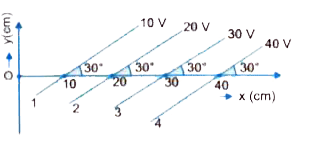The angle between the electric lines of force and an equipotential surface is
Step by step video solution for The angle between the electric lines of force and an equipotential surface is by Physics experts to help you in doubts & scoring excellent marks in Class 12 exams.
Updated on:21/07/2023Similar Questions
What is angle between electric field and equipotential surface?
View SolutionOn the basis of your understanding of the following paragraph and the related studied concepts.
An equipotential surface is a surface with a constant value of electric potential at all points on the surface. The component of electric field parallel to an equipotential surface is zero, as the potential does not change in this direction. Thus, the electric field is perpendicular to the equipotential surface at each point of the surface. Further, say the direction of electric field electrical potential gradually fall with distance.
Draw equipotential surfaces around an isolated positive point charge + q. Mark direction of electric field →E also.
View Solution
Knowledge Check
Equipotential surfaces
Aare closer in regions of large electric fields compared to regions of lower electric fieldsBwill be more crowded near sharp edges of a conductor.Cwill be more crowded near regions of large charge densitiesDwill aways be equally spacedLines of force cut equipotential surface
AobliquelyBnormallyCtangentiallyDat 45∘The electric field lines coming out of an equipotential surface are
Aperpendicular to the surfaceBparallel to the surfaceCin all directionsDzero
On the basis of your understanding of the following paragraph and the related studied concepts.
An equipotential surface is a surface with a constant value of electric potential at all points on the surface. The component of electric field parallel to an equipotential surface is zero, as the potential does not change in this direction. Thus, the electric field is perpendicular to the equipotential surface at each point of the surface. Further, say the direction of electric field electrical potential gradually fall with distance.
Four equipotential surfaces are shown in the adjoining figure. Find the magnitude and direaction of the electric field.

View SolutionOn the basis of your understanding of the following paragraph and the related studied concepts.
An equipotential surface is a surface with a constant value of electric potential at all points on the surface. The component of electric field parallel to an equipotential surface is zero, as the potential does not change in this direction. Thus, the electric field is perpendicular to the equipotential surface at each point of the surface. Further, say the direction of electric field electrical potential gradually fall with distance.
If a charge of 2 nC is taken from equipotential surface number 2 to 3, what is the amount of work done ?
View SolutionOn the basis of your understanding of the following paragraph and the related studied concepts.
An equipotential surface is a surface with a constant value of electric potential at all points on the surface. The component of electric field parallel to an equipotential surface is zero, as the potential does not change in this direction. Thus, the electric field is perpendicular to the equipotential surface at each point of the surface. Further, say the direction of electric field electrical potential gradually fall with distance.
If electric potential at origin point O be 100 V, then for electric field specified in part (b), draw equipotential surfaces corresponding to potentials 80 V, 60 V and 40 V respectively.
View SolutionConsider the following statements about equipotential surfaces and select the correct ones.
I. No work is required to be done to move a test charge between any two points on an equipotential surface.
II. Electric lines of force at the equipotential surfaces are mutually perpendicular to each other.
View SolutionAngle between →E and equipotential surface is always
View Solution